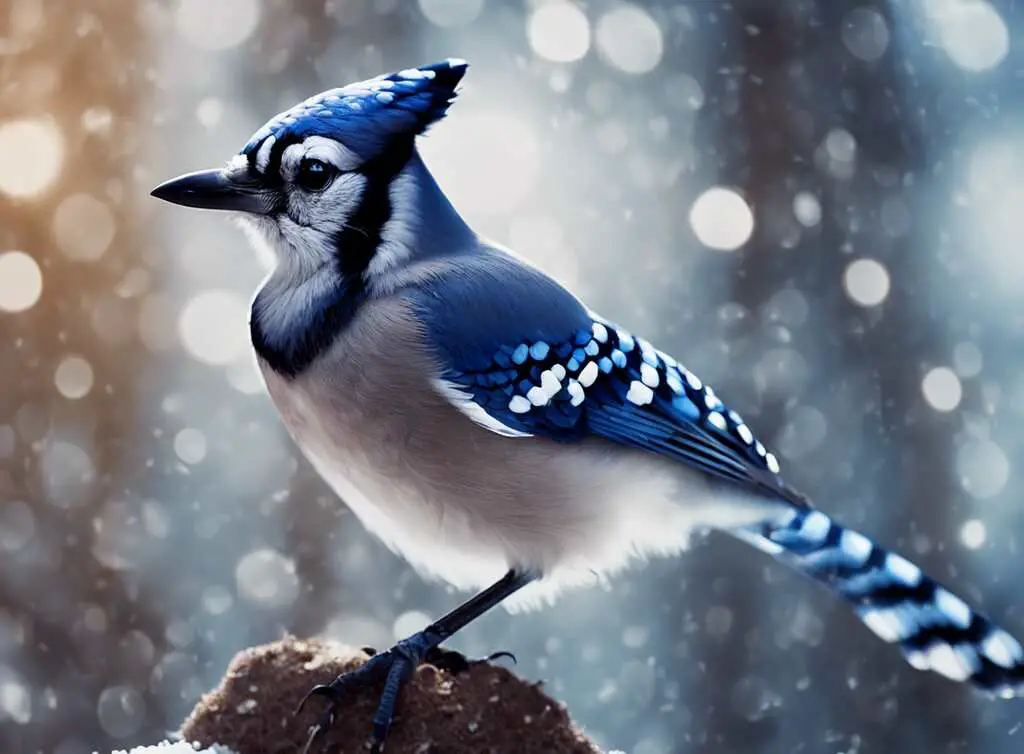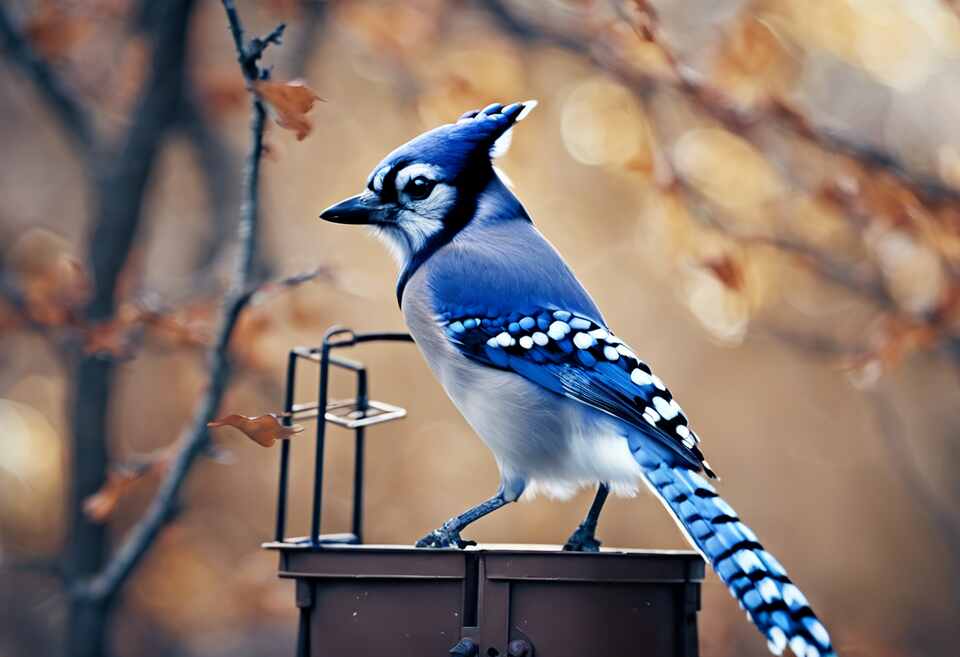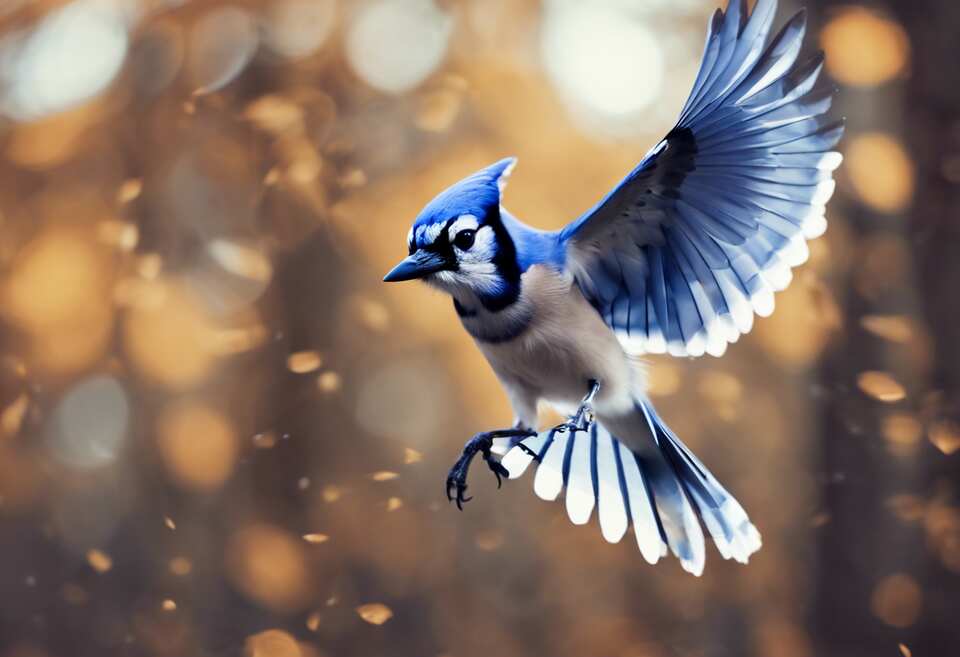Blue jays are known for their striking blue feathers and vibrant personalities. These beautiful birds are native to North America and belong to the Corvidae family, which includes ravens and crows. In addition to their stunning appearance, there are many fun facts about blue jays that make them fascinating creatures to learn about.
Table of Contents
Interesting Facts about Blue Jays
Blue Jays’ Appearance and Characteristics
Blue jays are recognized for their blue plumage with white chest and underparts. They also have a distinctive crest on their heads that they can raise and lower depending on their mood. Blue jays are medium-sized birds, typically measuring about 9 to 12 inches in length with a wingspan of 13 to 17 inches, and usually weighing between 2.5 to 3.5 ounces. Their wings and tail are marked with black, and they have a unique black band around their necks. Blue jays are quite vocal creatures and are known for their loud calls and mimicking abilities.
Blue Jays Are Not Actually Blue
Blue jays are renowned for their vibrant blue feathers, but did you know that their feathers aren’t actually blue? This striking coloration is the result of light refraction caused by the unique inner structure of their feathers. When light hits their feathers, it scatters in such a way that it creates the appearance of blue, making blue jays one of nature’s most fascinating optical illusions.
Intelligence and Communication
Blue jays are highly intelligent birds and are excellent at problem-solving tasks. They have complex social systems and communicate with each other using a wide range of vocalizations. Blue jays are also known for their remarkable ability to mimic the calls of hawks to warn other jays of potential predators in the area.
Nesting and Reproduction
Blue jays typically build their nests in the forks of trees 10-25 feet above the ground using mud, twigs, grass, rootlets and other plant materials. Both the male and female blue jays participate in building the nest, and both parents take turns incubating the eggs. Blue jays usually lay 3-6 eggs, which hatch after an incubation period of about 17-18 days. Once the chicks hatch, both parents are actively involved in feeding and caring for them.
Diet and Feeding Habits
Blue jays have a varied diet that includes fruits, insects, nuts, seeds, and even small vertebrates like frogs and lizards. They are also known to visit bird feeders in gardens to feed on seeds and nuts. Blue jays are excellent at storing food for later use and are known to hide nuts and seeds in the ground, a behavior known as “caching.”
Migration and Behavior
While some blue jays are year-round residents in their range, others may migrate south during the winter months. Blue jays are highly territorial birds and will aggressively defend their nesting territories from other birds and predators. They are also known to form groups called “screeches” that work together to mob predators like snakes and owls.
Symbolism and Cultural Significance
In Native American folklore, blue jays are often seen as symbols of communication, curiosity, and intelligence. They are believed to have spiritual significance and are associated with qualities like clarity, resourcefulness, and adaptability. Blue jays have also inspired artists, poets, and storytellers across various cultures throughout history.
Blue jays are not only stunning birds to observe but also fascinating creatures with unique behaviors and characteristics. Their intelligence, communication skills, and colorful appearance make them a beloved species in the wild. Whether you spot a blue jay in your backyard or while out on a hike, take a moment to appreciate these amazing birds and all the interesting facts that make them truly special.
Behavioral Patterns of Blue Jays
Blue jays are fascinating birds known for their striking blue plumage and distinct behaviors. Understanding the behavioral patterns of blue jays can provide valuable insights into their characteristics and habits.
Vocalizations
Blue jays are incredibly vocal birds and have a wide range of calls and songs. They can mimic the calls of other birds and even some human-made sounds. These birds are known for their loud jeering “jay-jay” calls, which can be heard from a far distance. Blue jays use their vocalizations to communicate with each other, warn of predators, and establish territories, making their voices an essential part of their behavior and survival.
Social Nature of Blue Jays
Blue jays are highly social birds that form strong bonds within their groups. They are often found in pairs or small family units and communicate through a wide range of vocalizations. These vocalizations serve various purposes, including warning calls, territorial disputes, and mate attraction.
Feeding Habits
Blue jays are omnivores with a diverse diet that includes nuts, seeds, insects, small rodents, and eggs. They are also known to visit bird feeders in suburban areas, where they can be observed feeding on sunflower seeds and suet. Blue jays are notorious for their habit of caching food, hiding nuts and seeds in various locations to consume later. This behavior helps them survive during times of scarcity.
Aggression and Defense
Blue jays are territorial birds that vigorously defend their nesting territories and food sources. They are known to exhibit aggressive behavior towards intruders, including other bird species. Blue jays have a distinctive crest on their heads, which they can raise when agitated or threatened, displaying their assertiveness.
Conclusion
Blue jays are fascinating creatures that captivate the attention of bird enthusiasts and nature lovers alike. Their vibrant blue plumage, distinctive calls, and intelligent behavior make them a delight to observe in the wild. Understanding the interesting facts about blue jays, such as their diet, habitat, and nesting habits, provides insight into their role in the ecosystem and their unique characteristics.
When exploring the behavioral patterns of blue jays, it becomes evident that they are highly social and communicative birds. Their loud calls and mimicry abilities help them establish territory, warn others of predators, and maintain connections within their flock. Additionally, their cunning nature and adaptability enable them to thrive in various environments, from forests to urban areas, demonstrating their resilience and resourcefulness.
Blue jays are known for their remarkable intelligence, problem-solving skills, and complex social structures. They exhibit cooperative breeding behavior, with family members assisting in raising and protecting the young. Their ability to cache food for later use showcases their forward-thinking mentality and strategic planning. By studying the behavioral patterns of blue jays, researchers gain valuable insights into avian cognition and social dynamics.
Blue jays are not just beautiful birds with striking blue feathers; they are also intelligent, resourceful, and highly adaptable creatures. Their interesting facts and behavioral patterns shed light on the intricate world of avian wildlife and offer a glimpse into the complexities of nature. By appreciating and respecting these enchanting birds, we can gain a deeper appreciation for the interconnectedness of all living beings in the natural world.
Next time you spot a blue jay perched in a tree or foraging for acorns, take a moment to marvel at the wonders of these magnificent creatures and the secrets they hold within their feathered forms.




